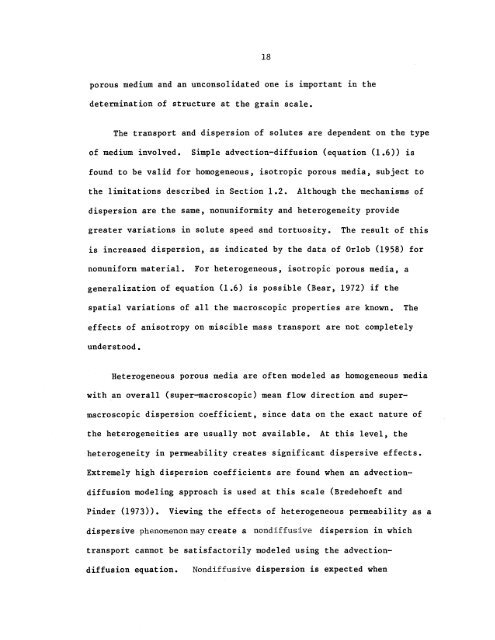longitudinal dispersion in nonuniform isotropic porous media
longitudinal dispersion in nonuniform isotropic porous media
longitudinal dispersion in nonuniform isotropic porous media
Create successful ePaper yourself
Turn your PDF publications into a flip-book with our unique Google optimized e-Paper software.
<strong>porous</strong> medium and an unconsolidated one 1S important <strong>in</strong> the<br />
18<br />
determ<strong>in</strong>ation of structure at the gra<strong>in</strong> scale.<br />
The transport and <strong>dispersion</strong> of solutes are dependent on the type<br />
of medium <strong>in</strong>volved. Simple advection-diffusion (equation (1.6)) is<br />
found to be valid for homogeneous, <strong>isotropic</strong> <strong>porous</strong> <strong>media</strong>, subject to<br />
the limitations described <strong>in</strong> Section 1.2. Although the mechanisms of<br />
<strong>dispersion</strong> are the same, <strong>nonuniform</strong>ity and heterogeneity provide<br />
greater variations <strong>in</strong> solute speed and tortuosity. The result of this<br />
is <strong>in</strong>creased <strong>dispersion</strong>, as <strong>in</strong>dicated by the data of Orlob (1958) for<br />
<strong>nonuniform</strong> material. For heterogeneous, <strong>isotropic</strong> <strong>porous</strong> <strong>media</strong>, a<br />
generalization of equation (1.6) is possible (Bear, 1972) if the<br />
spatial variations of all the macroscopic properties are known. The<br />
effects of anisotropy on miscible mass transport are not completely<br />
understood.<br />
Heterogeneous <strong>porous</strong> <strong>media</strong> are often modeled as homogeneous <strong>media</strong><br />
with an overall (super-macroscopic) mean flow direction and super<br />
macroscopic <strong>dispersion</strong> coefficient, s<strong>in</strong>ce data on the exact nature of<br />
the heterogeneities are usually not available. At this level, the<br />
heterogeneity <strong>in</strong> permeability creates significant dispersive effects.<br />
Extremely high <strong>dispersion</strong> coefficients are found when an advection<br />
diffusion model<strong>in</strong>g approach is used at this scale (Bredehoeft and<br />
P<strong>in</strong>der (1973)). View<strong>in</strong>g the effects of heterogeneous permeability as a<br />
dispersive phenomenon may create a nondiffusive <strong>dispersion</strong> <strong>in</strong> which<br />
transport cannot be satisfactorily modeled us<strong>in</strong>g the advection-<br />
diffusion equation. Nondiffusive <strong>dispersion</strong> is expected when

















